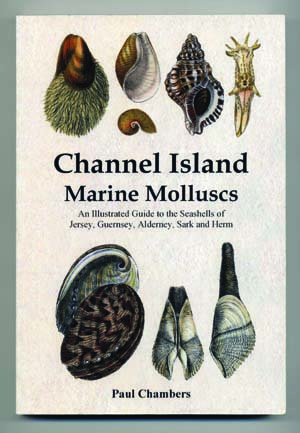Channel Island Marine Molluscs: An Illustrated Guide to the Seashells of Jersey, Guernsey, Alderney, Sark and Herm.Paul Chambers published by Charonia Media, 2008. Paperback, 322pp.
 Paul Chambers grew up on Jersey with a strong interest in marine biology and collecting shells. In his late teens he started compiling Jersey marine invertebrate references and kept a card catalogue. As a London-based student in Geology/Palaeontology he continued to search out useful references using several London libraries. The last hour of a student day was applied to combing the literature: Forbes & Hanley, Jeffreys, Montagu, Donovan, Alder & Hancock……….
Paul Chambers grew up on Jersey with a strong interest in marine biology and collecting shells. In his late teens he started compiling Jersey marine invertebrate references and kept a card catalogue. As a London-based student in Geology/Palaeontology he continued to search out useful references using several London libraries. The last hour of a student day was applied to combing the literature: Forbes & Hanley, Jeffreys, Montagu, Donovan, Alder & Hancock……….
It was an article by the Jersey pharmacist Eugene Duprey on the shells of Jersey that prompted Paul to assess those records, many of the names being old, and compare it with his card catalogue. This was the stimulus to draw up a Checklist of Jersey molluscs. He returned to Jersey to look again, combining practical collecting with a new tool in the form of a microscope. It was the moment to expand his catalogue to cover all marine/maritime species of the Channel Islands.
This published version under review is restricted to the marine Mollusca and contains information on identification which focuses on the salient features highlighted by others and includes Paul’s own local observations. But, despite the implications of the book’s title, it is not an identification guide, and it should be clear that the book is not aimed at the newcomer to marine molluscs. There are other books and several websites to help the novice get started.
Distributional information only goes up to Seaward’s Distribution of the Marine Molluscs of North West Europe (1990). All documented records that Paul unearthed are incorporated including ‘doubtfuls’. The author has included almost none of his own records, Caecum vitreum being an exception. He has drawn on figures from old publications to illustrate the species. In their reproduced form these can give no more than an idea as to the appearance of the animals.
Channel Islands Marine Molluscs is an “eccentric and self-published” book. The set-up costs were low and copies are printed on demand. It is an “imperfect” document in that there are errors but these are continually being corrected on the master version as they are drawn to the attention of the author. There is a partial preview on Google Books where you can take a look at the opening sections and selected pages from the body of the book, including the index.
As you leaf through the book you will be struck by the wealth of marine mollusc species that the Channel Islands support (479). Jersey has a spectacular diversity of shore types and the magnitude of some beaches means that on the lowest of spring tides the island’s area is effectively doubled. The island presents a rewarding opportunity to record a wide range of molluscs including several Southern species rare outside the Channel Islands, and to collect their shells. Armed with a copy of Paul’s book you will know which shores to visit, and what you might expect to find there. It also presents a challenge to expand our knowledge of Jersey localities and what species they support.
